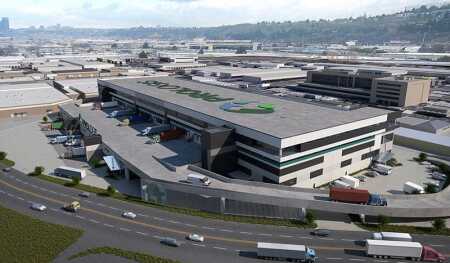After years out of the spotlight, the global industrial sector is one of the hottest asset classes in real estate today.
“After so many years of not receiving attention, industrial is being sought after by practically every institutional investor,” said Mark Hansen, managing director with San Francisco–based Prologis, a global leader in logistics real estate, at ULI’s 2018 Spring Meeting in Detroit. “It’s an exciting time to be in industrial. Demand from tenants is increasing every day.”
Speaking at the “What’s Coming Down the Road for Industrial Development” panel chaired by John M. Walsh III, chief executive officer and a founder of TIG Real Estate Services, a Frisco, Texas–based full-service real estate company, panelists agreed that industrial has become the golden child of assets.
“Today, it’s the darling of the income property sector,” agreed John S. Hagestad, senior managing director/principal at Irvine, California–based SARES-REGIS Group, a developer of commercial and residential real estate services throughout the western United States. “Everyone wants industrial product; institutions can’t get enough of it. Industrial has evolved from old manufacturing or distribution warehouses to a good-looking product—incorporating significant design—that you would take delight in putting on the cover of a brochure.”
E-commerce has brought industrial into the 21st century, he adds, and technology has become more sophisticated in today’s industrial offerings, including such features as early suppression fast response (ESFR) systems. “We have become much more sophisticated in building industrial buildings and are constructing larger structures—500,000 square feet [46,500 sq m] and greater, with clear heights of 34 feet [10.3 m] and some as high as 40 feet [12.2 m].”
More important, industrial developers are constructing product that provides flexibility for tenant users, with more container parking storage and additional car parking if the tenant is an e-commerce user. “We build in a lot of flexibility in our industrial product so if someone wants it, it’s there,” added Hagestad.
Tenants are also demanding more power. “Who would have thought a building would need 8,000 or 10,000 amps of power?” asked Hansen. “But clients are demanding it. Amazon is building mini–intelligent buildings with large power needs for racking. Some facilities even have a medical center in them.”
While industrial developers are planning for the future, they are not making any plans for autonomous trucks just yet. “We try to understand what tenants and users want in the years ahead and incorporate that into our buildings,” said Hagestad. “We’re not doing anything today specifically today toward driverless trucking. We all know it’s coming and understand we are going to see driverless trucks. If something comes up in the future, particularly, if Mark says, ‘You need to incorporate these things into buildings,’ we will do it.”
Because of rising land costs, multistory industrial facilities are expected in the years ahead, added Jack Fraker, a vice chairman and managing director of CBRE Global Industrial & Logistics, based in Dallas, who notes that multistory industrial buildings are being constructed in the Far East. “In Asia, land is so expensive, they had to go up with their building,” he added. “We’re seeing it in Seattle and it has to happen in other places where land is so expensive.”
Hansen told attendees that Prologis is teaming up with tech companies to explore synergies between technology and their buildings. “We’re all trying to figure out what the future holds,” he continues. “Warehouses are becoming much more ‘just in time’ and must have technology in them to deal with it. It’s at the beginning of some interesting things.”
Hansen added that to take away some of the uncertainty of expenses for tenants, Prologis—one of the largest landlords in the world—is using a new branded Clear LeaseTM. In addition to the base rent, industrial tenants pay a guaranteed amount of their pro-rata share of common-area maintenance (CAM), property insurance, management fees, and capital repairs and replacements. The tenant also pays its pro-rata share of property taxes, but this payment is not guaranteed.
Most tenants feel the pain of estimated operating expenses at the end of the year when the landlord tells them how much the actual expenses were. With the Clear LeaseTM, Hansen said, Prologis is taking away the friction between customer and landlord, giving them surety and capital expense protection.
“Telling our customers how much they are expected to pay—everything but property taxes—in the [lease] takes away the friction, where you go back at the end of the year and say, ‘Hey, you owe us $50,000 more,” he continued. “It’s well received by customers. They have one number they sign up with.”
Developers and owners of industrial properties also have contingency plans in the event of an active shooter incident or a hurricane. “We have a regional structure around the country and regional teams responsible for local portfolios,” Hansen added. “We have a plan in place and everybody knows their job. When Hurricane Harvey happened, our teams were out there, getting our buildings back on line as it was safe to do so.”
More abundant information has also changed the industrial sector. “I remember 20 to 30 years ago, there wasn’t much information out there,” added Fraker. “Developers just went out and built a spec building. Today there is a lot more data available, including Google Earth.”





